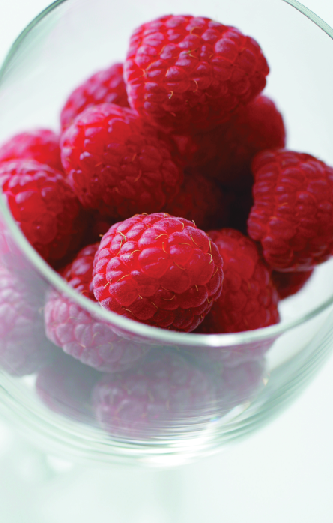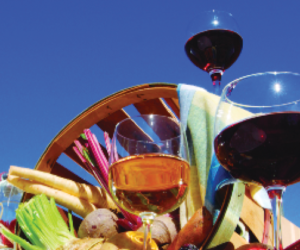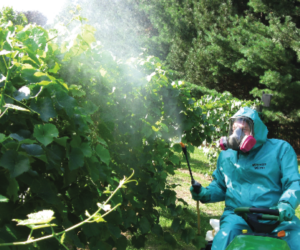 Grapes want to be wine. That may be oversimplified, but the fact is that the vast majority of commercial wines — and most homemade wines — use winegrapes as their base. The balance of flavors, aromas, sugar and acid that naturally occurs in grapes is unmatched by any other fruit for the direct production of a pleasing adult beverage. That does not mean, however, that there cannot be excellent wines made from other fruits. It just means the winemaker may have to work a little harder to get there.
Grapes want to be wine. That may be oversimplified, but the fact is that the vast majority of commercial wines — and most homemade wines — use winegrapes as their base. The balance of flavors, aromas, sugar and acid that naturally occurs in grapes is unmatched by any other fruit for the direct production of a pleasing adult beverage. That does not mean, however, that there cannot be excellent wines made from other fruits. It just means the winemaker may have to work a little harder to get there.
Grape wine must is generally prepared with fruit present for red wines and as juice without fruit for whites and rosés. While flavors and aromas vary greatly by variety and terroir, there are some common ranges for key attributes such as sugar and acid. To produce a table wine, the percent sugar by weight (°Brix) is usually between 20 and 26, while the acid is most commonly between 0.5 and 0.8 g/100 mL. For most wine styles, the winemaker looks for TA levels of about 0.6 to 0.7. We will look in this article at the sources of acid in fruit wines and steps that can be taken to bring levels into this desirable range. Unless otherwise noted, “acid” here means titratable acidity (TA) expressed in grams per one hundred milliliters as tartaric acid. The g/100 mL units can be viewed as approximately percent and titratable acidity is usually considered synonymous with total acidity. Other units the home winemaker may encounter include TA in grams per liter; that number is simply ten times the g/100 mL expression. One other slight complication may come from reading European publications, where TA is expressed as sulfuric acid. In the American system, it is always tartaric acid, which is the dominant acid of grapes. That is, the entire acid content, when titrated, is calculated as though it consisted of tartaric acid alone.
In grapes, the widest likely spread of tartaric acid concentrations might be from about 0.2 g/100 mL to 1.0 g/100 mL. Malic acid is next most common, ranging from a low of 0.1 to a high of 0.8. Beyond those acids, some traces of citric acid may occur, accounting for 0.02 to perhaps 0.03. For non-commercial winemakers it is not usually an issue, but high citric acid can be a source of high diacetyl and acetic acid from MLF. In most grape musts, the citric acid is negligible and lactic acid is not present until malolactic fermentation has taken place. Whatever the composition, TA is still expressed as though all the acids were tartaric.
In other fruits, other acid conventions may be used. Apples are generally described in terms of malic acid content (their dominant acid) and many other fruits are reported as citric acid. In making acid adjustments to fruit wines, the winemaker has a choice of food-grade acids to use. Home winemaking shops sell pure tartaric, citric, and malic acids. Many also sell acid blends. A common recipe for an acid blend is (by weight) 8 parts citric acid, 4 parts tartaric acid, and 1 part malic acid.
Because of the different equivalent weights of the acids, they have different effects when compared by weight with tartaric acid. One gram of malic acid contains acidity equal to 1.12 grams of tartaric acid and one gram of citric acid represents the acidity of 1.17 grams of tartaric. As a practical matter, these are fairly interchangeable (although chemically they are different). For maximum precision, however, you will need to take this difference into account. That is, if your calculations call for adding one gram of tartaric acid, but you wish to use malic acid for flavor or fruit compatibility reasons, divide 1 by 1.12 and use just 0.9 grams of malic in place of each gram of tartaric. Correspondingly, use 1/1.17 or 0.85 grams of citric acid for each gram of tartaric. For acid blend, you will need to figure the contributions of each component. For the acid blend described above, this looks like ((8 x 1.17) + (4 x 1) + (1 x 1.12))/13 = 1.11 grams effective tartaric acid addition for each gram of this blend.
Winemakers can choose tartaric acid for simplicity of additions, or a standard or custom blend for particular flavor objectives. In human sensitivity, equivalent amounts of acid are perceived as proceeding from more sour to less sour as: malic>tartaric>citric>lactic. Complicating the perception further is the counter-acting effect of ethanol or sugar. At equivalent acid levels, presence of sugar or of moderate levels of alcohol will reduce the apparent sourness. Excessive tannic astringency or bitterness, however, will amplify the apparent sourness.
In making fruit wine, water is often added. In some cases, the addition is needed because juice is difficult to extract directly from the fruit. This is generally the case with plum wine, for instance, where crushing and pressing is difficult and produces a low yield. In other cases, water may be added to reduce excessive acidity or tannins to palatable wine levels. In any case, addition of water will probably mean sugar must be added as well to achieve a reasonable final alcohol level. Further sugar additions may be desirable at bottling to enhance fruitiness and round out flavors. In many respects, fruit wines resemble grape wines that are white or pink. They are generally best consumed when young and fresh. They may benefit from sweetening before bottling. And they need a “bright” flavor of sufficient acidity to be pleasantly refreshing. Red wines, and fruit wines that resemble them (such as blueberry), may be more pleasant at somewhat lower acid levels.
Just as with grapes, other fruits can vary widely in acidity. For reference, some mid-range values (as percent tartaric) are as follows*:
Apple 0.8
Plum 1.0
Cherry 1.1
Blackberry 1.4
Raspberry 1.9
Loganberry 2.3
Currant 2.5
If juice or must is prepared directly from such fruits, acid levels are at or above those usually desired in finished wine. Although a substantial sweetening may provide balance (as with lemonade), a more pleasing result will usually be achieved if water is added to dilute the acid level into an acceptable range. In many cases, a suitable must or juice cannot be prepared directly from the fruit and water will be needed to aid processing and fermentation. Unless the dilution is just right for the acid present, acid will need to be added back.
Ultimately, an acid titration is necessary to determine the TA level of any juice or wine. Available TA test kits range from inexpensive sets that use phenolphthalein indicator and a syringe for titration, up to those that use an electronic bench-top pH meter and a glass buret. If you can physically obtain juice from your fruit of choice and you intend to ferment that, the acid or water addition needed can be calculated directly from your TA test results on the fresh juice. Choose a target acid level for your first batch with a new fruit based on the fruit’s resemblance to grapes and your flavor objectives. We will call that target value “A.” For many fruits, that level could be 0.65 g/100 mL, and that value will be used in the following example calculations.
If your fruit juice titrates with a TA higher than your “A” target, figure your required water addition as follows:
(TA/A) x gallons of juice = final gallons, diluted
Final gallons, diluted – gallons of juice = gallons of water
to add
For example, suppose you have 3 gallons of blackberry juice with a TA of 1.4 and we want 0.65:
(1.4/0.65) x 3 = 6.5 gallons as diluted
6.5 – 3 = 3.5 gallons of water to add
Of course, sugar will need to be added as well, but that is another story.
If the TA of your juice is lower than desired, calculate your acid addition as follows:
(A – TA) x 37.85 x gallons of juice = grams of acid to add
For example, suppose you have 5 gallons of apple juice that tests with a TA of 0.55 and you want 0.65:
(0.65 – 0.55) x 37.85 x 5 = 19 grams of acid to add
If you will not be fermenting the juice directly, the recipe you follow will generally advise a specific weight of whole fruit to be crushed, mashed, or cut and combined with water for a specified final volume. In nearly every such recipe, some acid will need to be added. Since there is no simple way to determine the TA of whole fruit, the winemaker can start with published values and make further adjustments later. Acid in grams per 100 mL (or in percent weight/volume) can be reasonably estimated as equal to grams per 100 grams (or percent weight/weight) since water weighs one gram per mL. With that in mind, you can calculate the total likely acid contribution from your fruit, compare it with the result to be achieved in your target volume, and estimate a needed acid addition.
Once again, calling the target acid level A and using the literature value for the whole fruit as TA (as percent tartaric acid), calculate your needed acid addition as follows:
TA x 4.54 x lbs. of fruit = grams of acid from fruit
A x 37.85 x gallons of wine = total grams of acid for finished wine
Total grams of acid for finished wine – grams of acid from fruit = grams of acid to add
For example, suppose your recipe for five gallons of plum wine calls for 15 pounds of pitted plums. From the list above, we will assume the plums have a TA of 1.0% (equivalent to 1.0 g/100 g and approximately 1.0 g/100 mL) and our desired level for the finished wine is again 0.65:
1.0 x 4.54 x 15 = 68 grams of acid from fruit
0.65 x 37.85 x 5 = 123 grams of acid total for finished wine
123 grams – 68 grams = 55 grams to add
One final note about fruit wine acid additions concerns additions to wine that then need some correction later. It is always best to manipulate any wine — grape or fruit or vegetable — as little as possible to achieve the desired result. With that in mind, you may want to under-adjust the juice or must somewhat on the first addition. For example, add, say, just three quarters of the calculated dilution water or half the calculated acid. Allow the fermentation to proceed for a few days, thief out a sample for another TA test, and calculate again. You can use the juice equations above to determine if you want to go ahead and add more water or acid. Doing the additions in this step-wise manner means you will not need to correct back in the opposite direction later: less manipulation to produce better wine.
*Data adapted from Jackisch, Philip, Modern Winemaking, Cornell University Press, Ithaca, 1985.







